1997 CADILLAC ELDORADO engine
[x] Cancel search: enginePage 81 of 361

Downloaded from www.Manualslib.com manuals search engine Your vehicle is equipped
with
the BASS-Key I1
theft-deterrent system.
PASS-Key
I1 is a passive
system. The system is
med when the key
is
removed from the ignition.
BASS-Key
11 uses a resistor pellet in the ignition key
that is read by the system in your vehicle. If the key
resistor matches the code stored
in the vehicle system,
the vehicle’s
fuel and starting systems will be enabled. If
an incorrect key is used, the vehicle’s fuel and starting
systems are disabled for three minutes. Additional
attempts Curing this
lockout period will not start the car,
even with the correct key.
If the engine does not start and the “STARTING
DISABLED DUE TO THEFT SYSTEM, REMOVE
IGNITION KEY message is displayed in the Driver
Information Center,
your key should be checked for
damage. Starting may
be attempted with an undamaged
key immediately. See your Cadillac dealer
or a
locksmith for key service.
If the “STARTING DISABLED DUE TO THEFT
SYSTEM, REMOVE IGNITION KEY” and “WAIT
3 MINUTES” messages are displayed, the key should
be cleaned. After three minutes,
try again. A “START
CAR” message will appear at this time. If the engine
still does not start, wait three minutes and
try a duplicate
key. At this time,
fuses should be checked (see “Fuses
and Circuit Breakers” in
the Index). If the engine does
not start with the duplicate key, your vehicle needs
service. See your Cadillac dealer for service.
If the “THEFT SYSTEM PROBLEM” message is
displayed during vehicle operation, your vehicle needs
servicing. Your vehicle
will restart if you turn it off,
however, your vehicle
may be unprotected. See your
Cadillac dealer for service.
If an ignition key is lost or damaged, see your Cadillac
dealer
or a locksmith to have a new key made.
Page 82 of 361

Downloaded from www.Manualslib.com manuals search engine e 99
~~~~~~~~ ~
Your modern Cadillac doesn’t need an elaborate
“break-in? But
it will perform better in the long
run if you follow these guidelines:
cb
Don’t drive at any one speed -- fast or
slow
-- for the first 508 miles ($05 hm).
Don’t make full-throttle starts.
Avoid making hard stops
for the first
200 miles (322 km) or so. During this time
your new brake linings aren’t yet broken
in. Hard stops with new linings can mean
premature wear
and earlier replacement.
Follow this breaking-in guideline every
time you get new brake linings.
Donst tow a trailer during break-in.
See “Towing a Trailer” in the Index for
more
information.
si s
If your key seems stuck in LOCK and YOU canst
turn it, be sure you’are using the correct key;
if so, is it all the way in? If it is, them turn the
steering wheel left and right while
you turn the
bey hard. But turn the key only with your hand.
Using a tool to force it odd break the key OF the
ignition switch.
If none OF this works, then your
vehicle needs service.
Page 83 of 361
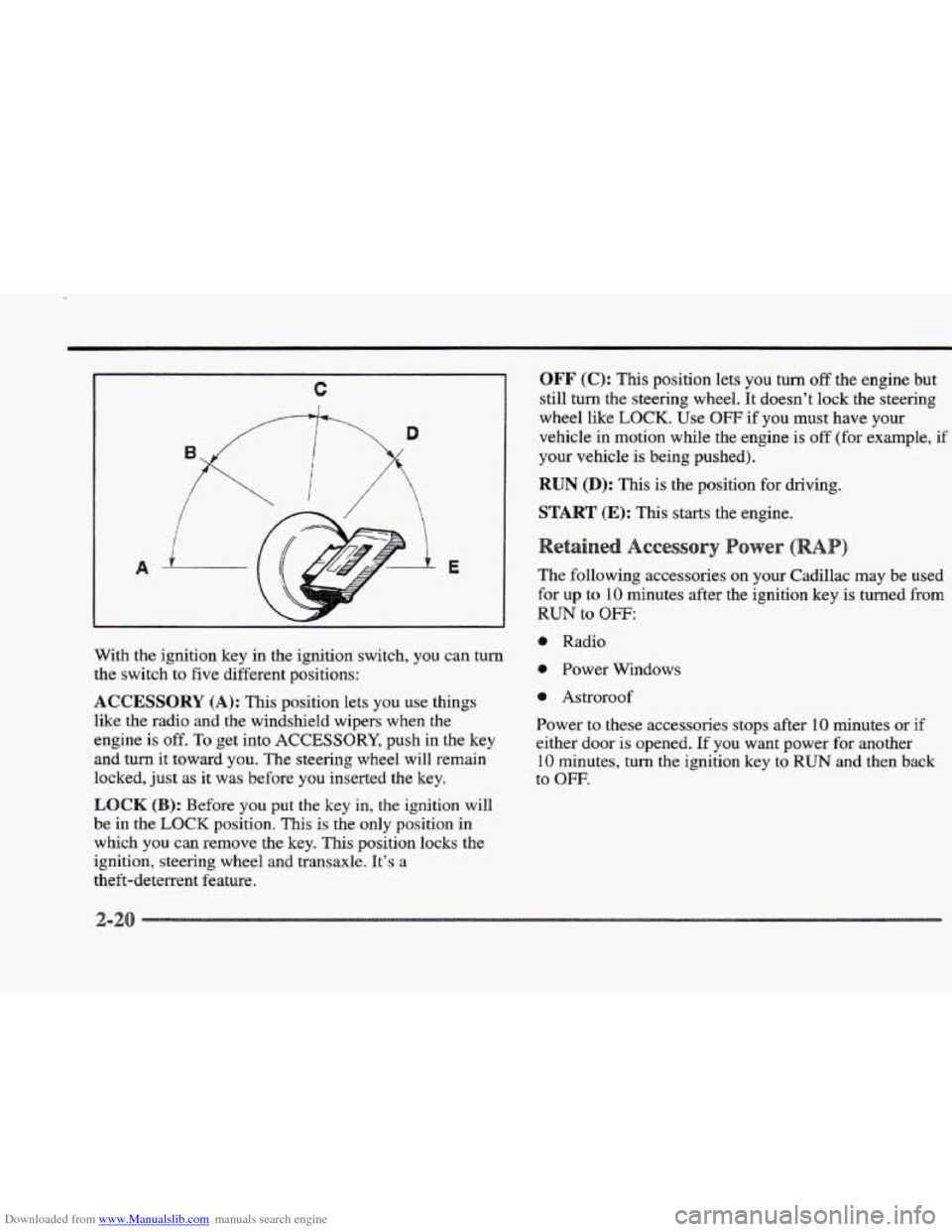
Downloaded from www.Manualslib.com manuals search engine c
With the ignition key in the ignition switch, you can turn
the switch
to five different positions:
ACCESSORY (A): This position lets you use things
like the radio and the windsheld wipers when the
engine is off.
To get into ACCESSORY, push in the key
and turn it toward you. The steering wheel will remain
locked, just as it was before you inserted
the key.
LOCK (B): Before you put the key in, the ignition will
be
in the LOCK position. This is the only position in
which you can remove the key. This position locks the
ignition, steering wheel and transaxle.
It’s a
theft-deterrent feature.
OFF (C): This position lets you turn off the engine but
still
turn the steering wheel. It doesn’t lock the steening
wheel like
LOCK. Use OFF if you must have your
vehicle
in motion while the engine is off (for example, if
your vehicle is being pushed).
RUN (D): This is the position for driving.
START (E): This starts the engine.
Accessory
The following accessories on your Cadillac may be used
for up to 10 minutes after
the ignition key is turned from
RUN to OFF:
@ Radio
e Power Windows
@ Astroroof
Power to these accessories stops after
10 minutes or if
either door is opened. If you want power for another
10 minutes, turn the ignition key to RUN and then back
to OFF.
Page 84 of 361
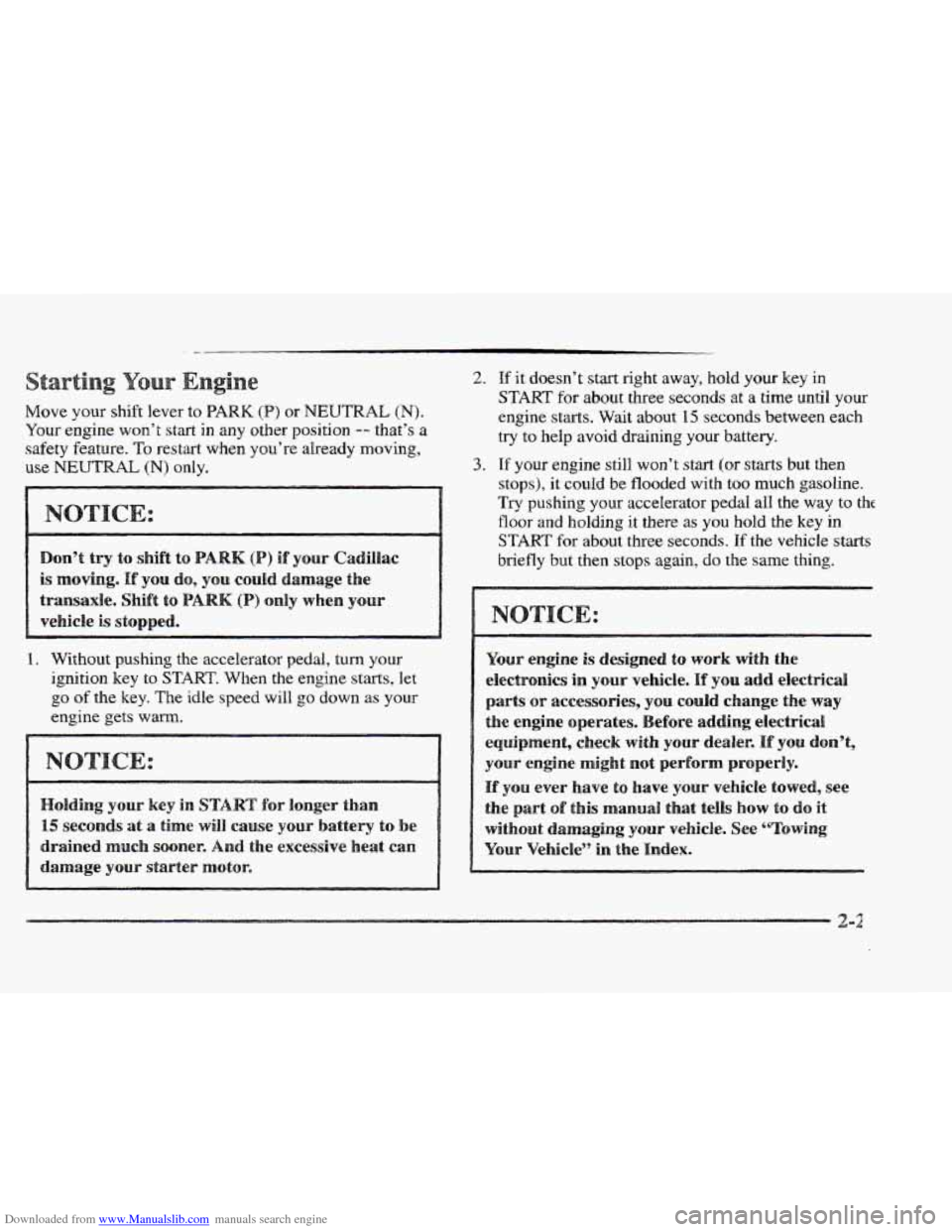
Downloaded from www.Manualslib.com manuals search engine Move your shift lever to PARK (B) or NEUTRAL (N).
Your engine won’t start in any other position -- that’s a
safety feature. To restart when you’re already moving,
use NEUTRAL (N) only.
a e
Don9$ try t0 shift &O (P) if YOUr CadihC
is moving. If you do, you could damage the
transaxle. Shift to PARK (P) only when your
vehicle is stopped.
1. Without pushing the accelerator pedal, turn your
ignition key
to START. When the engine starts, let
go of the key. The idle speed will1 go down as your
engine gets warm.
2. If ,it doesn’t start right away, hold your key in
START for about three seconds at a time until your
engine starts.
Wait about 15 seconds between each
try to help avoid draining your battery.
3. If your engine still won’t start (or starts but then
stops),
it could be flooded with too much gasoline.
Try pushing your accelerator pedal all the way to thc
floor and holding it there as you hold the key in
START for about three seconds. If the vehicle starts
briefly but then stops again, do the same thing.
e 0
Your engine is designed 80 work with the
electronics
in your vehicle. Hf YOU add electrical
parts or accessories, you could change the way
the engine operates. Before adding electrical
equipment, check with your dealer. If YOU don’t,
your enginme might not perform properly.
the part of this manual that teh how t~ do it
Your Vehicle” in the Index.
IF you ever have to have your vehicle towed, see
without damaging your vehicle. See “Towing
Page 85 of 361
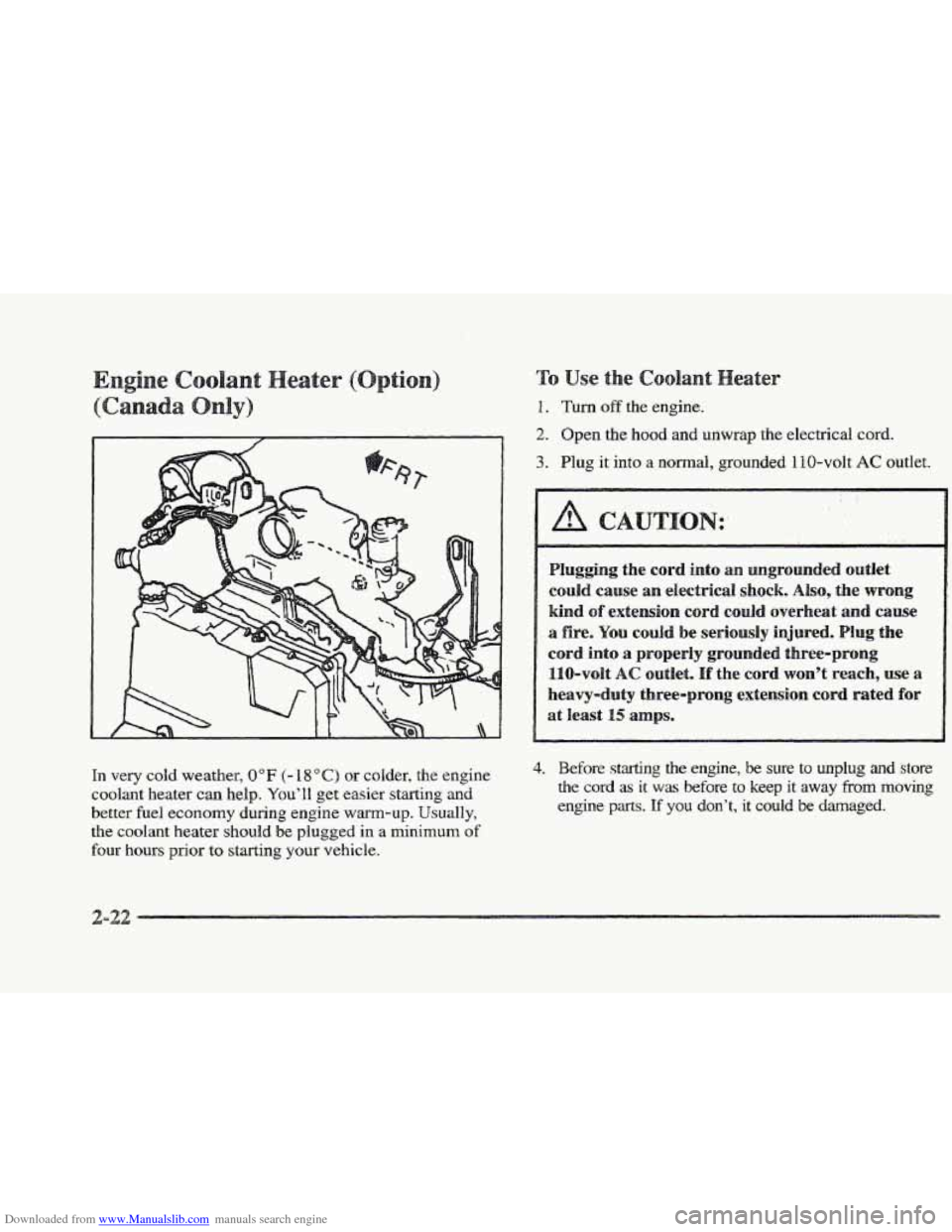
Downloaded from www.Manualslib.com manuals search engine 1. Turn off the engine.
2. Open the hood and unwrap the electrical cord.
3. Plug it into a normal, grounded 1 IO-volt AC outlet.
..
In very cold weather, WF (- 18 "C) or colder, the engine
coolant heater can help. You'll get easier starting and
better
fuel economy during engine warm-up. Usually,
the coolant heater should be plugged in a minimum of
four hours prior to starting your vehicle.
4. Before starting the engine, be sure to unplug and store
the cord as it was before to keep it away from moving
engine
parts. If you don't, it could be bmaged.
Page 86 of 361
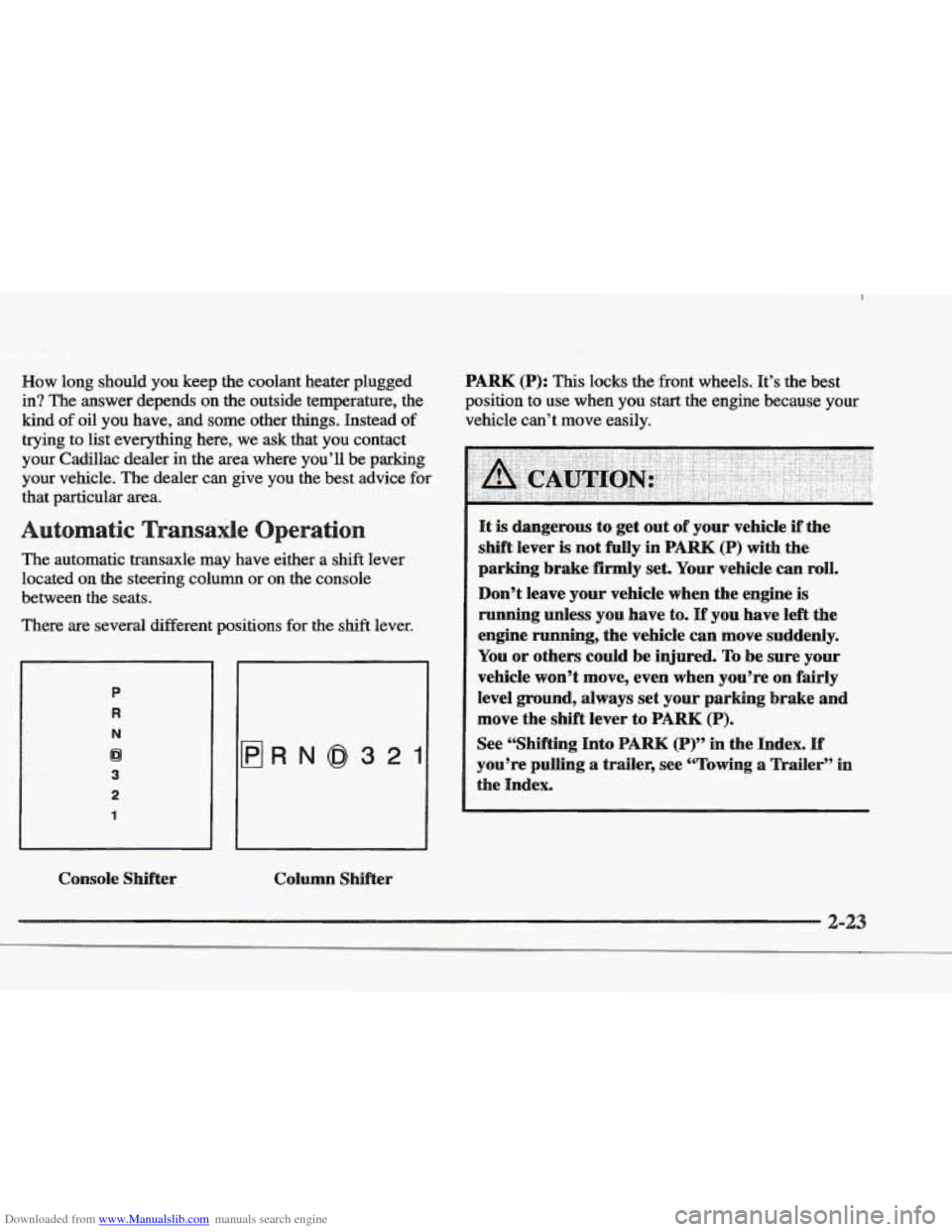
Downloaded from www.Manualslib.com manuals search engine How long should you keep the coolant heater plugged
in? The answer depends on the outside temperature, the
kind
of oil you have, and some other things. Instead of
trying to list everything here, we ask that you contact
your Cadillac dealer in the area where you’ll be parking
your vehicle. The dealer can give you the best advice for
that particular area.
The automatic transaxle may have either a shift lever
located on the steering
column or on the console
between
the seats.
There are several different positions for the
shift lever.
P
R
N
Dl
3
2
1
HRN@321
Console Shifter Collnmn Shifter PARK
(P): This locks
the.front wheels. It’s the best
position to use when you start the engine because your
vehicle can’t move easily.
It is dangerous to get out of your vehicle if the
shift lever
is not fully in PARK (P) with the
parking brake firmly set. Your vehicle
can roll.
Don’t leave your vehicle when the engine
is
running unless you have to. If you have left the
engine running, the vehicle can move suddenly.
You
or others could be injured. To be sure your
vehicle won’t move, even when you’re on fairly
leveI ground, always set your
parking brake and
move the shift lever to
PARK (P).
See “Shifting Into PARK (P)” in the Index. If
you’re pulling a trailer, see “Towing a Trailer” in
the Index.
2-23
Page 87 of 361

Downloaded from www.Manualslib.com manuals search engine Ensure the shift lever is fully in PARK (P) range before
starting the engine.
Your Cadillac has a brake-transaxle
shift interlock.
You have to fully apply your regular
brakes
before you can shift from PARK (P) when the
ignition key is in the RUN position. If you cannot shift
out
of PARK (P), ease pressure on the shift lever -- push
the shift lever all the way
into PARK (P) and release the
shift lever button
QII the floor shift console models as
you maintain brake application. Then move the shift
lever into the gear
you wish. (Press the shift lever button
before moving the shift lever on floor shift console
models.) See “Shifting Out
of PARK (P)” in this section.
EVERSE (It): Use this gear to back up.
Also use this gear to J-QC~ your vehicle back and forth to
get out of snow, ice or sand without damaging your
transaxle. See “If You’re Stuck in Sand, Mud, Ice or
Snow” in the Index for additional information.
NEUTRAL (N): In this position, the engine
doesn’t connect with
the wheels. To restart when you’re
already moving, use
NEUTRAL (N) only. Also, use
NEUTRAL (N) when your vehicle is being towed.
Shifting out of PARK (P) or NEUTWAL (N) while
your engine
is “racing” (running at high speed) is
dangerous. Unless your foot is firmly on the
brake pedal, your vehicle coulld move very
rapidly.
You could lose control and hit people or
objects. Don’t shift
out of PARK (P) or
NEUTRAL (N) while your engine is racing.
Damage to your transaxle caused by shifting out
of PARK (P) or NEWTML (N) with the engine
racing isn’t covered by your warranty.
Page 88 of 361
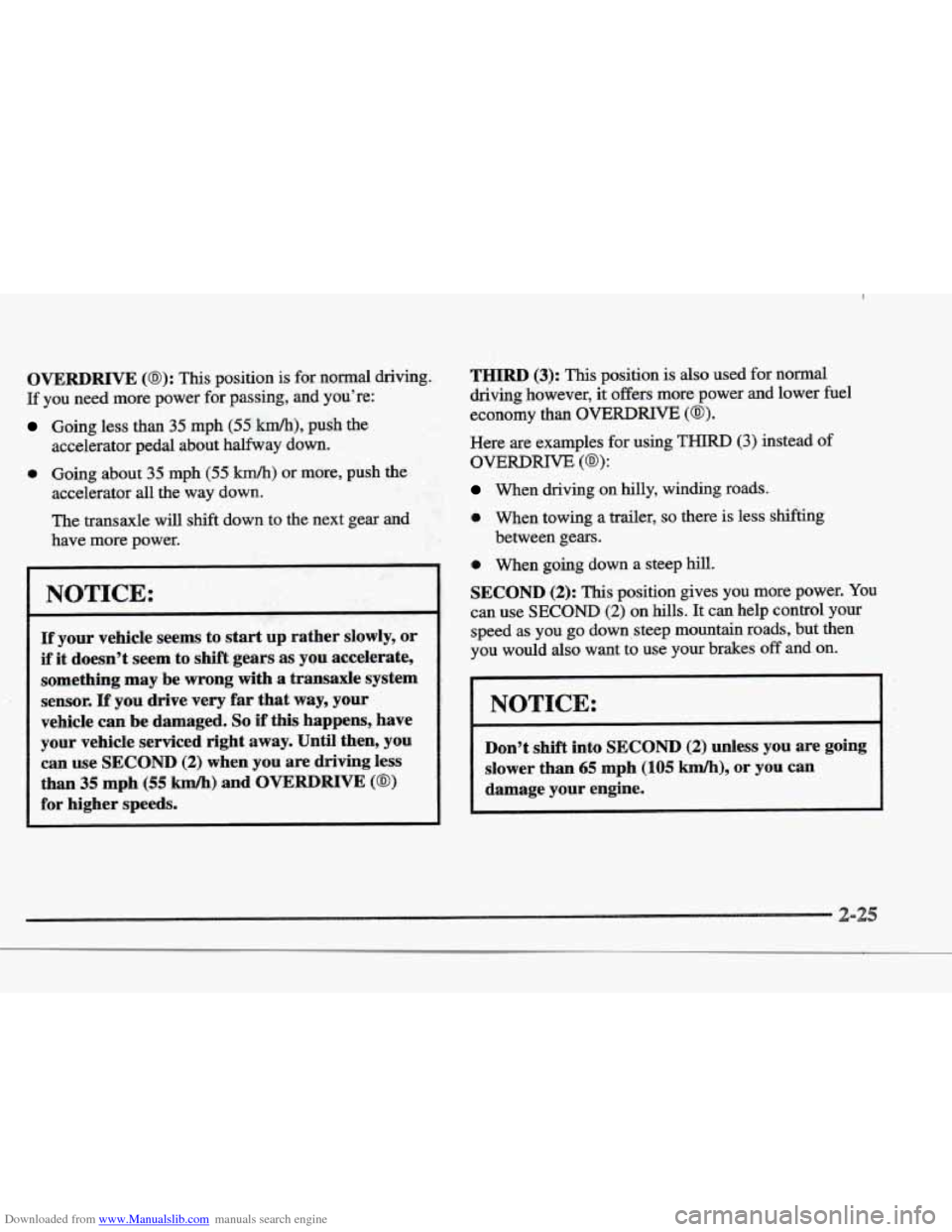
Downloaded from www.Manualslib.com manuals search engine OVERDRIVE (@): This position is for normal driving.
If you need more power for passing, and you’re:
Going less than 35 mph (55 km/h), push the
accelerator pedal about halfivay down.
a Going about 35 mph (55 km/h) or more, push the
accelerator all the way down.
The transaxle will shift down to the next gear and
have more power.
NOTICE:
If your vehicle seems to start up rather slowly, or
if it doesn’t seem to shift gears as YOU accelerate,
something may be wrong with
a transaxle system
sensor.
If you drive very far that way, your
vehicle
can be damaged. So if this happ,ens, have
your vehicle serviced right away. Until then, you
can use SECOND (2) when you are driving less
than
35 mph (55 km/h) and OVERDRIVE (@)
for higher speeds.
THIRD (3): This position is also used for normal
driving however, it offers more power
and lower fuel
economy than OVERDRIVE (GB).
Here are examples for using THIRD (3) instead of
When driving on hilly, winding roads.
0 When towing a trailer, so there is less shihing
0 When going down a steep hill.
SECOND (2): This position gives you more power. You
can use SECOND (2) on hills. It canhelp control your
speed as you
go down,steep mountain roads, but then
you would
also want to use your brakes off and on.
OVERDRIVE (@):
between gears.
Don’t shift into SECOND (2) unless YOU are going
slower
than 65 mph (105 km/h), or you can